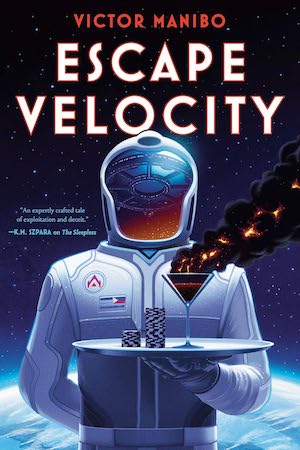A high school reunion—the perfect time to see everyone you’d forgotten, and lean on your high-flying friends who have done better. And no one and nowhere is more high-flying than the characters of Victor Manibo’s Escape Velocity: the children of senators and corporate executives and famous talent agents who have grown up into those roles themselves, hosted at the orbital Altaire space hotel.
But the vastness of space, the ability to look down on Earth and see it in its entirety, is no reprieve from the petty infighting, factionalism, and secrets that define their lives. The book’s cold open sees Henry Gallagher—the happily married scion and CEO of a world-spanning pharmaceutical agency—tossed out into space with no jetpack fuel and slowly running out of oxygen. His only hope is to drift close enough to a communications satellite to call for help; but it’s a faint, forlorn hope, and a far cry from the glitzy shuttle that took him up into space.
Though the book is set in 2089, politics has largely stagnated or gotten worse since the present day, with dictatorships or corporate oligarchies holding power in much of the world, and climate change wreaking havoc across the world with rising seas and raging wildfires. The big draw, then, is in jockeying to live on Mars: New habitats are opening up in just a few years, but there are limited spots available. The whole reason Henry Gallagher and his husband went up to the Altaire in the first place was to barter for those slots.
Few of his former Rochford classmates are faring any better. Tom Lazaro III (“Laz”), a diplomat who’s risen in the ranks due to his family’s last name, is morose about his chances of either getting to Mars or ever finding a partner. Charles Sloane IV, a wealthy layabout concerned about his reputation, is a financial dom for an aerospace magnate. And all three—Henry, Laz, and Sloane—are suspects in a decades-old murder.
Buy the Book


Escape Velocity
In their senior year of high school, 25 years ago, Ava Khan’s brother was murdered. His death came just days after a bloody fight with the three boys, in which they told him to stop hurting Ava—or else. But they had lawyers, and money, and the immunity to lie to the police about their fight, and so it was Ava’s poor, drug-running girlfriend Daniela who was accused instead, and who was killed in a prison riot shortly after. Ava knows who was responsible for her death—but since Daniela didn’t kill Ashwin Khan, she needs to find out who did.
And yet all of this, despite being where the most page time is spent, is arguably backdrop for the true drive of the book. The Altaire might be a space hotel, but it doesn’t operate in a vacuum. The Rochford alumni are outnumbered on the hotel by the staff, crew, and security services, who are screwed over by the system that these rich and powerful have built. (One example: Time in space is a benefit for the “merit-based” Mars application, but there are labor exemptions; the alumni on the Altaire for three days are seeing their scores bumped, but the staff aren’t.)
It’s something modern murder mysteries are having to grapple with more and more: the fact that many of the staples of the genre place them exclusively among the rich. Part of it are the settings: It’s much harder to get a deserted country manor, a private island during a thunderstorm, an exclusive boarding school, or—as in Escape Velocity—a booked-out orbital hotel. Part of it are the motivations: The rich have the leeway to kill for far more idiosyncratic reasons, and in far more complex ways, when survival or basic needs aren’t the stakes. Part of it are the detectives, where they exist, who often are upper-class themselves or move in all the same circles, giving them an easy entry point into the mystery.
How do authors (or filmmakers, or producers) change the genre, then, while still leaving it recognizable? Some don’t, of course—there are still no shortage of mysteries among and solved by the wealthy, whether they be socialites or antique collectors. Some, like the Knives Out series, become satires on the people involved, where an outsider character or detective exposes the foibles and ridiculousness of the wealthy. Some, like the Siri Paiboun series, by Colin Cotterill, put in the work to their protagonist and their settings to set up whodunits among the poor.
And then there’s Escape Velocity. As we get deeper into the novel, it becomes less of a murder mystery and more of a manifesto against the wealthy people that populate the Altaire. Piece by piece, the novel works to make them all wholly unsympathetic, whether they be the investigators like Ava; the suspects like Henry, Laz, or Sloane; or the bystanders who engage in their own cruelties—so that we as readers reach our breaking point with the characters at the same time the staff and crew of the Altaire do.
It’s not a classic murder mystery, but if you’re looking for a politically aware spin on the genre, Escape Velocity is your book. (And as a bonus: Make sure to look closely at the cover art by Sam Chivers—there are a bunch of small details in there I only picked up after reading!)
Escape Velocity is published by Erewhon Books.
Read an excerpt.










